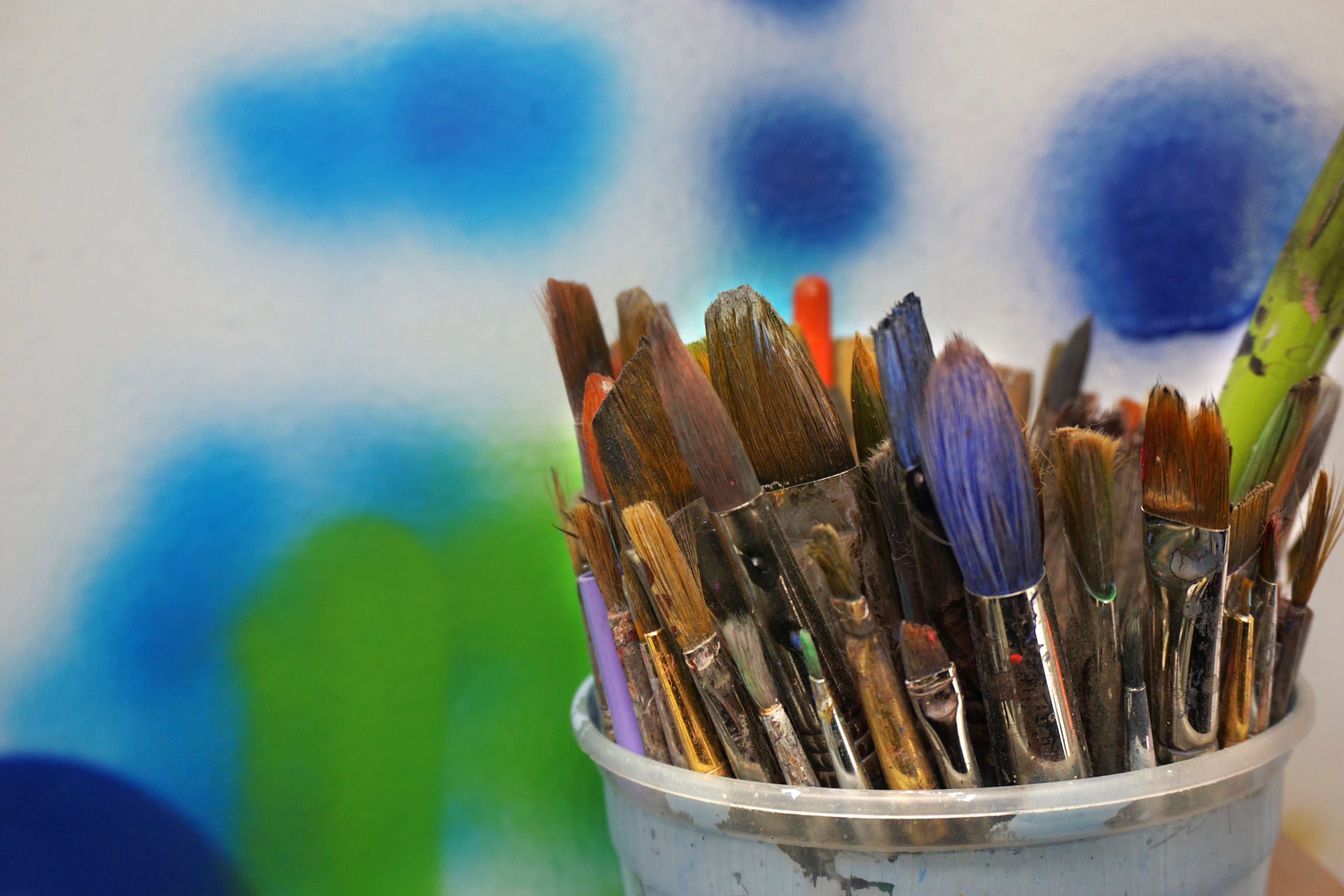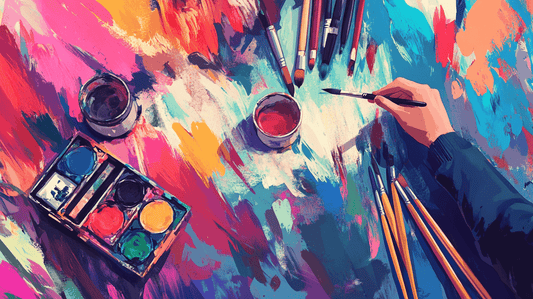Cleaning Paintbrushes
Paintbrushes are some of the most important tools in an artist’s kit, and proper cleaning is vital to their longevity. Depending on the type of paint you’re using, the cleaning methods can vary.
Cleaning Different Types of Brushes
- Water-based Paints (Acrylics, Watercolors): These brushes should be cleaned immediately after use. Rinse them thoroughly in lukewarm water, making sure to remove all paint. For acrylics, a gentle soap like dish detergent can help remove stubborn paint. Watercolors are easier to clean as they dissolve in water, but it’s still essential to clean the bristles gently to prevent build-up.
- Oil-based Paints: Cleaning oil paintbrushes requires a bit more effort. First, wipe off excess paint with a cloth or paper towel, then dip the brush into a solvent like mineral spirits or turpentine. After the paint is dissolved, rinse the brush with soap and water, and then reshape the bristles.
Drying and Storing Paintbrushes
After cleaning, proper drying is crucial to prevent damage. Gently reshape the bristles and lay the brush flat to dry. Never leave brushes standing in water or solvent for prolonged periods, as this can bend the bristles and cause the ferrule to rust. For long-term storage, it’s best to store brushes with the bristles facing up or flat in a brush holder to maintain their shape and quality.
Caring for Paints
Caring for your paints is just as important as cleaning your brushes. Whether you’re working with acrylics, oils, or watercolors, storing paints correctly ensures they maintain their quality and consistency.
Sealing and Storing Different Paint Types
- Acrylic Paints: To prevent acrylic paints from drying out, ensure lids are tightly sealed after use. If you’re using a palette for mixing, cover the palette with a damp cloth or use an airtight container to keep the paint fresh for later use.
- Oil Paints: Oil paints naturally take longer to dry, but it’s still essential to close the tubes tightly after use. Store them in a cool, dry place to avoid excessive hardening.
- Watercolors: Watercolor paints are generally low-maintenance, but it’s important to keep the pans or tubes clean and free of dust. Store your watercolor set in a closed container to avoid contamination.
Extending the Life of Paint Containers
To extend the life of paint tubes and containers, always squeeze paint from the bottom to avoid creating air pockets that can cause premature drying. Keep the caps and lids free of dried paint, as this can make it difficult to close them properly, which can lead to leakage or drying.
Maintaining Drawing Pencils and Charcoal
Pencils and charcoal sticks are delicate tools that require specific care to avoid breakage and smudging.
Sharpening Techniques
When sharpening drawing pencils, it’s best to use a manual sharpener to avoid unnecessary breakage. Electric sharpeners can be too harsh and may shorten the life of your pencils. For charcoal and pastel pencils, use a blade or sandpaper block to carefully sharpen the tips without snapping them.
Proper Storage
Store pencils, charcoal, and pastels in a way that minimizes contact with other materials. Pencil cases or drawers with separators are ideal for this. Charcoal, in particular, is prone to breaking, so keeping it in a sturdy, padded case helps protect it from damage.
Preventing Smudging
To prevent smudging, keep fixatives on hand to spray your finished charcoal or pencil drawings. When storing unfinished works, place them between sheets of tracing paper or in portfolios to avoid rubbing against other surfaces.
Protecting Your Canvas and Paper
Artists often invest heavily in their canvases and papers, and protecting these surfaces is essential to preserving your artwork and ensuring the materials remain usable over time.
Storing Unused Canvases and Paper
Canvases should be stored in a dry, cool environment, away from direct sunlight, to prevent warping. It’s a good idea to stack canvases vertically rather than laying them flat, as this prevents unnecessary weight on the surface that could cause indentations. For paper, use archival folders or cases to protect it from dust, moisture, and damage.
Handling and Framing Finished Works
When handling finished works, especially those on paper, always use clean, dry hands or wear cotton gloves to avoid transferring oils or dirt onto the artwork. For long-term preservation, framing your work behind UV-protective glass can shield it from light damage, dust, and environmental factors.
Long-term Storage for Artwork
Store finished works in a dry, cool place, preferably in a dedicated portfolio or archival box. Avoid places with fluctuating temperatures, like basements or attics, as these environments can damage paper and canvas over time.
Caring for Miscellaneous Art Supplies
While brushes and paints tend to get the most attention, other tools in your studio require care as well.
Maintaining Palettes, Easels, and Other Tools
- Palettes: Clean your palette after every session to prevent dried paint from accumulating. For acrylics, wipe the palette while the paint is still wet. Oil paint palettes can be cleaned with a palette knife and solvent.
- Easels: Wipe down your easel occasionally to remove dust and paint splatters. If it’s a wooden easel, occasionally treat it with furniture polish to keep the wood from drying out.
Palette Knives and Blending Tools
Clean palette knives immediately after use to prevent paint from hardening on the blade. For blending tools like sponges and rags, clean them thoroughly or replace them regularly to avoid contamination of colors in your future projects.
Erasers and Sharpeners
Keep erasers clean by rubbing them on a scrap piece of paper to remove built-up graphite or charcoal. Sharpeners should be emptied regularly, and their blades can be cleaned with a cotton swab dipped in rubbing alcohol.
Conclusion
Caring for your art supplies is an essential practice that not only extends their life but also enhances your overall artistic experience. When you invest time in maintaining your tools, you’re not only saving money but also ensuring that your materials perform at their best. Whether it’s cleaning your brushes properly, sealing your paint tubes, or storing your finished artwork safely, these small efforts can significantly improve your art journey. So, take the time to nurture your tools—it’s a worthwhile investment that will pay off in both the short and long term.
Whether you're a professional artist or a hobbyist, we have all the art supplies you need to fuel your creativity. From paints and brushes to canvas and sketchpads, shop our wide selection online or visit us in-store to find top-quality materials for your next masterpiece.





